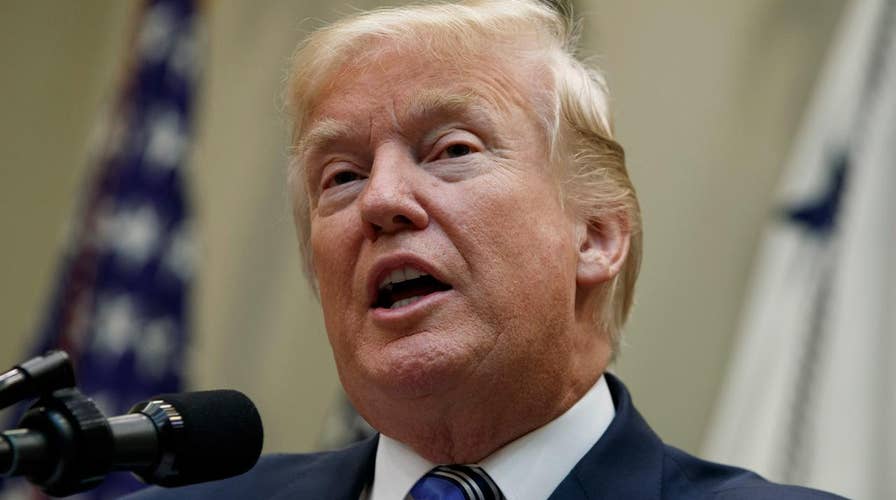Decoding The Debate: Trump's Policy On Transgender Individuals In The Military

Table of Contents
The Initial Ban and its Rationale
In July 2017, President Trump announced a ban on transgender individuals serving in the military, reversing the Obama administration's policy that allowed open service. The stated rationale behind this decision was multifaceted and heavily contested. The Trump administration cited several key justifications:
- Concerns about Military Readiness and Unit Cohesion: The administration argued that the presence of transgender individuals would disrupt unit cohesion and negatively impact military readiness. This claim, however, lacked substantial evidence and was widely disputed by military experts and LGBTQ+ advocacy groups who pointed to the successful integration of openly gay and lesbian service members.
- Alleged High Healthcare Costs: Another justification centered on the purportedly high healthcare costs associated with transgender service members' medical transition-related care. Critics countered that these costs were significantly lower than initially suggested and were often comparable to other medical expenses incurred by military personnel.
- Potential Security Risks: The administration vaguely alluded to potential security risks associated with transgender service members, but this assertion remained largely unsubstantiated and lacked concrete evidence. This claim fueled further criticism for its lack of transparency and reliance on unsubstantiated fears.
Counterarguments from LGBTQ+ advocacy groups and military experts highlighted the discriminatory nature of the ban, emphasizing the service and sacrifice of transgender individuals, and the importance of inclusivity in creating a strong and diverse military force. They argued that the ban would harm morale, recruitment efforts, and retention rates.
Legal Challenges and Court Battles
The ban immediately faced significant legal challenges, resulting in a series of high-profile court battles. Numerous lawsuits were filed by transgender service members and LGBTQ+ advocacy organizations, challenging the constitutionality and discriminatory nature of the policy.
- Key arguments from plaintiffs: Plaintiffs argued that the ban violated the Equal Protection Clause of the Fourteenth Amendment, citing discrimination based on gender identity.
- Government's defense: The government defended the ban by claiming it was necessary for military readiness and efficiency. However, the lack of concrete evidence supporting these claims weakened their argument.
The legal battles saw a series of rulings, some temporarily blocking the ban's implementation, ultimately leading to a complex and evolving legal landscape surrounding the issue. Key cases and their outcomes included: (Specific cases and their outcomes would be listed here with citations). These legal battles illustrated the profound constitutional and human rights implications embedded within Trump's policy on transgender individuals in the military.
The Impact on Transgender Service Members
The ban's impact on transgender service members was devastating. Many faced uncertainty about their futures, fear of discharge, and increased discrimination within the ranks. The policy created a climate of fear and uncertainty, impacting morale, recruitment, and retention rates. (Insert personal stories here, if ethically sourced and appropriately anonymized, highlighting the human cost of the policy). The mental health consequences were significant, with many reporting increased anxiety, depression, and suicidal ideation as a direct result of the discriminatory policies. This underscored the far-reaching human toll of Trump's decision.
Political and Social Ramifications
Trump's policy ignited a broader national discussion about LGBTQ+ rights and the role of the military in society. It became a key issue in the political landscape, further polarizing opinions along party lines. The policy's impact extended beyond the US, affecting international relations and perceptions of American values.
- Political landscape: The ban became a central point of contention in political campaigns and debates, highlighting the increasing political weight of LGBTQ+ issues.
- Public opinion: Public opinion was deeply divided, reflecting broader societal divisions on transgender rights.
- International relations: The policy strained relationships with some international allies who had more inclusive policies towards transgender individuals in their military forces.
The role of political parties and interest groups in shaping the debate was also significant, with LGBTQ+ advocacy groups vigorously fighting against the ban and conservative groups often supporting it.
The Biden Administration's Response
Upon taking office, the Biden administration swiftly reversed Trump's policy, issuing a memorandum allowing transgender individuals to serve openly in the military. This decision marked a significant step towards inclusivity and equality in the armed forces. While the reversal represented progress, challenges remain in ensuring equal opportunity and addressing the lingering effects of the previous ban. Ongoing efforts focus on providing necessary healthcare, addressing past discrimination, and promoting an inclusive environment within the military.
Conclusion: Understanding Trump's Legacy on Transgender Military Service
Trump's policy on transgender individuals in the military remains a controversial and impactful chapter in American history. This policy, driven by unsubstantiated claims about readiness and costs, caused significant harm to transgender service members and ignited intense legal and political battles. While the Biden administration has reversed the ban, the lingering effects of this discriminatory policy, including its impact on recruitment, retention, and the mental health of transgender service members, are profound. To fully understand the lasting consequences of Trump's policy on transgender individuals in the military, it is crucial to continue researching and engaging in respectful dialogue. You can find further information through organizations such as the American Civil Liberties Union (ACLU) and the Human Rights Campaign (HRC). Let's continue the conversation and work towards a more inclusive and equitable military for all.

Featured Posts
-
 Will Palantir Be A Trillion Dollar Company By 2030 An In Depth Analysis
May 10, 2025
Will Palantir Be A Trillion Dollar Company By 2030 An In Depth Analysis
May 10, 2025 -
 Dijon Rue Michel Servet Conducteur Se Rend Apres Avoir Percute Un Mur Avec Son Vehicule
May 10, 2025
Dijon Rue Michel Servet Conducteur Se Rend Apres Avoir Percute Un Mur Avec Son Vehicule
May 10, 2025 -
 Nigerian Petrol Prices Understanding The Influence Of Dangote And Nnpc
May 10, 2025
Nigerian Petrol Prices Understanding The Influence Of Dangote And Nnpc
May 10, 2025 -
 Imf Review Of Pakistans 1 3 Billion Loan Package Latest Updates
May 10, 2025
Imf Review Of Pakistans 1 3 Billion Loan Package Latest Updates
May 10, 2025 -
 Apple At The Ai Frontier A Deep Dive Into Its Strengths And Weaknesses
May 10, 2025
Apple At The Ai Frontier A Deep Dive Into Its Strengths And Weaknesses
May 10, 2025
